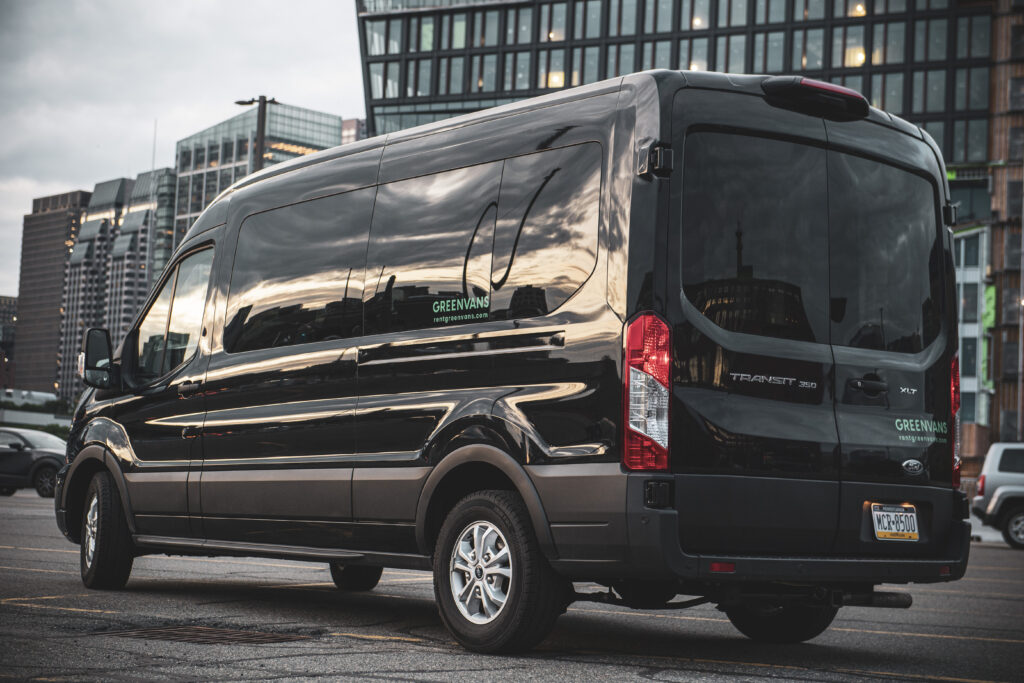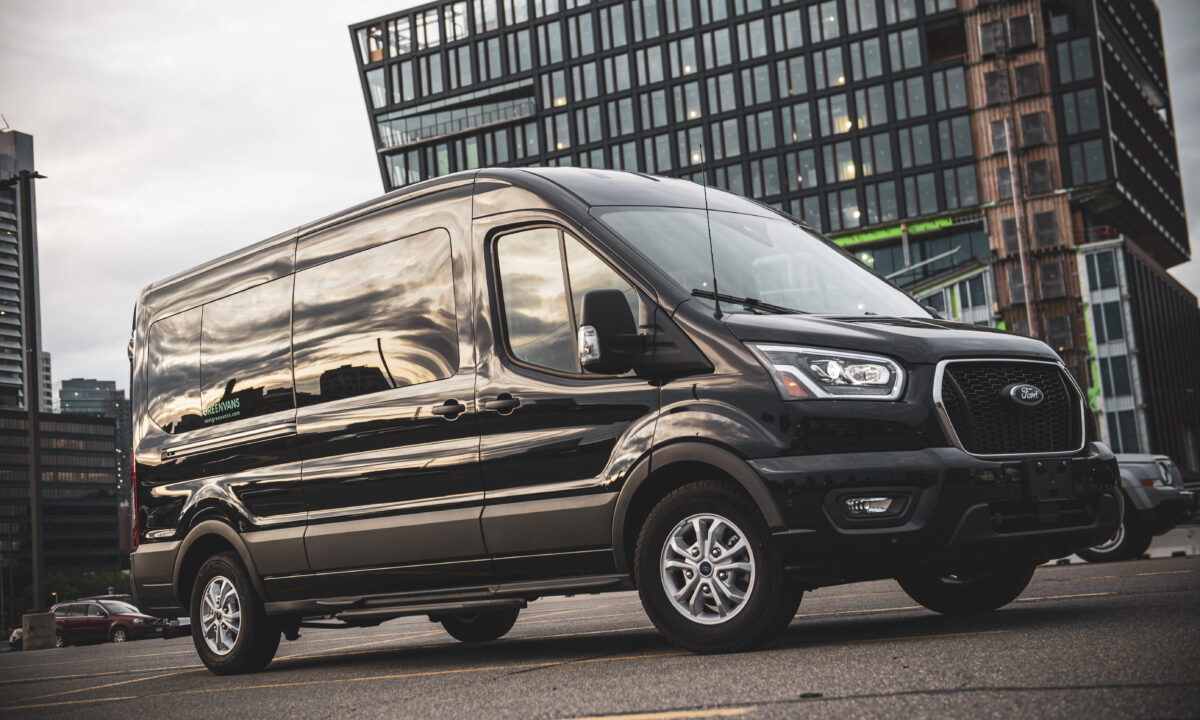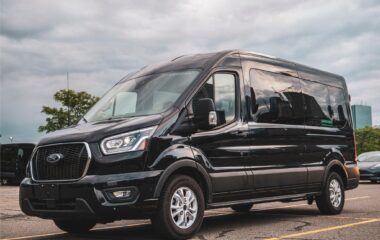So, you’ve never rented a van before, and you’re feeling a little intimidated by the process. Perhaps you’re wondering which van you need, how to load it, and where to rent it. If the questions keep piling up, you’ve come to the right place. Our detailed guide will show you everything from choosing the right size vehicle for your group to driving tips. Once you’ve read it all, you’ll know exactly how to rent a van for your next road trip!
Greenvans’ essential pre-rental information
What do you need to know before you hire a van? Here are four specific considerations when starting the rental process.
Choosing the right van configuration
The first decision to make is what van rental size is right for your group. In the case of passenger vans like our Greenvans vehicles, most are identical in measurements and chassis – what changes is the number of seats. So, whether you rent a 15-passenger van or an 8-passenger van, the body will be the same size. Seats will be removed to accommodate the passengers and amount of cargo you’ll be bringing.
Required documents
Now, we need to think about what documents are needed to rent a van. While all agencies are unique, most require the same paperwork as Greenvans:
- An up-to-date driver’s license (No special license is required to drive a passenger van).
- A valid credit card
- Proof of insurance including primary liability and collision coverage.
Additionally, all drivers must be 21 or older to rent a van from Greenvans.
Read more: Rental vans and cars age limits: A complete guide
Insurance options

Insurance criteria can feel confusing, so let’s break it down clearly and efficiently. There are several types of van rental insurance, which include:
- Liability Insurance: This is mandatory and essential for legal compliance, no matter where you’re renting from.
- Collision Damage Waiver (CDW): CDW is an optional add-on that covers damage to the rental vehicle itself, regardless of who is at fault. It is often used interchangeably with Renters Collision Protection.
- Personal Accident/Effects Insurance (PAI/PEI): PAI/PEI are two optional add-ons, often bundled, which provide coverage for medical expenses or damage to personal items in the event of an accident.
- Supplemental Liability Insurance (SLI): SLI gives you extra liability coverage beyond what’s included with standard liability protection, useful if a third-party claim is made against you.
If there’s anything you’d like to clarify about the different insurance options and what might serve you best, don’t hesitate to consult with the expert customer service staff at Greenvans.
First-time van rental checklist
Before driving a van for the first time, take a look at our detailed checklist that outlines important steps like:
- Pickup info: Know exactly which documents you need to retrieve your van, as well as the address where you will pick it up. Greenvans has seven locations throughout the Eastern U.S. and offers customized drop offs for added convenience, including curbside airport deliveries.
- Tolls: Most agencies offer two options to pay tolls while on the road. With Greenvans, choose to bring your own EZ Pass (or equivalent) transponder, which is the more economical choice. Alternatively, we offer a third-party pay-by-plate service which will charge your card on file each time you pass through a toll.
- Mileage: Wherever you choose to rent, define if there’s a daily mileage limit and how many miles are included. Greenvans, for example, offers an industry-high 300 miles per day, with a $0.39 per mile fee once exceeded. If you’re planning a robust cross-country road trip and feel this is too low, ask about our unlimited mileage package and save money.
- Fuel: You should be given a rental van with a full tank, and the van should be returned with a full tank. Make it easier by mapping out the closest gas stations to the dropoff location when starting your journey.
- Van condition: It’s important to return the van in the same condition you received it to avoid cleaning fees or maintenance costs. Check the interior and exterior of the vehicle before departing, pointing out any imperfections to the agent.
- Rental agreement: Your rental agreement will define agency terms and expectations, helping you avoid any miscommunications (or bad surprises) down the road.
Read our blog post Things to consider when renting a van for a cross-country trip for a full van inspection checklist.
Preparing for the drive with your rental van
Now that you know how to rent a van for a road trip, it’s time to get clear on how to drive it.
Understanding Ford Transit handling
Here are a few common questions and answers regarding our Ford Transit passenger vans.
- Is the Ford Transit difficult to drive? Because a Ford Transit is noticeably larger and heavier than a car, it can take a bit of getting used to. However, most renters find their footing relatively quickly and find that despite its size, it’s easy to drive.
- What’s the difference between handling cars and Ford Transit vans? The most obvious difference is the larger turning radius, and tight maneuvers may feel more challenging at first. Additionally, the elevated driving position creates larger blind spots, so you may rely more heavily on side mirrors and vehicle cameras. Braking distances are also longer in a van due to its increased weight, especially when loaded.
- How can I get comfortable driving a van? Start by adjusting the seat for optimal visibility and comfort. Next, adjust side mirrors to minimize blind spots. If it suits you, practice turning and parking in an open parking lot to get familiar with the van’s dimensions.
Safely loading your van
To maintain balance and stability, it’s critical to distribute weight evenly. This includes passengers and cargo and especially applies to those driving a van for the first time. When packing the van, place heavier items on the bottom and secure all cargo with tie-downs or straps to prevent shifting during transit.
Hitting the road: Tips for driving a Ford Transit rental van

It’s finally the moment to get behind the wheel. With these tips, you’ll be smooth sailing in no time.
Navigating with a larger vehicle
It’s no secret that driving a Ford Transit requires different skills than driving a sedan. When you are:
- Turning: Approach corners slowly and allow extra space for the rear of the van to clear any obstacles. Swing wide when making turns and always switch on your turn signal well in advance to alert other drivers.
- Parking: Take your time! Reserve into parking spots, using side mirrors and backup cameras to ensure you’ve got plenty of space.
- Handling wind: Vans can be more susceptible to wind gusts due to their height and surface area. Keep both hands firmly gripped on the steering wheel and adjust as necessary to stay in your lane.
Staying comfortable on the road
Driver comfort is key to a successful journey. To keep relaxed yet alert, here are a few suggestions:
- Take breaks: Plan your itinerary to make plenty of stops. Whether you choose to stretch your legs at a rest stop or take a nature break at a National Park, it’s important to step away from the vehicle frequently.
- Use apps: Download driver-friendly apps before you go. Waze and Google Maps will indicate the clearest routes to take according to current traffic patterns, while Spotify and SiruisXM will provide on-the-road entertainment.
- Utilize van features: On longer trips, take advantage of features like cruise control and lane assist to ensure a smooth journey.
Returning your van rental to Greenvans
The adventure is over! For the time being, anyway. Thankfully, it’s just as easy to return as it is to hire a van.
Return in top condition
Avoid unexpected fees by returning the van as clean as you found it. Remove all belongings, check seat pockets, and discard trash before dropping it off with a full tank of gas.
Final inspection
One of the most costly mistakes is failing to inspect the van for unnoticed damage before returning it. There should be no garbage, food crumbs, or sticky materials in the vehicle, and no evidence of smoking. Doing so could result in fines up to $500 or more.

Renting with confidence: Why choose Greenvans?
We know there are a lot of renting agencies out there and plenty of questions regarding who to work with. Narrow your choices by weighing the options between renting from an independent vs. commercial agency. Even though big brands usually have more locations, it’s the boutique companies that are renowned for providing consistent and personalized customer service.
Including the hardworking staff at Greenvans, who are always ready to assist. Not only are our reps experts in the industry, they’re able to customize any rental to your group. From the number of seats to packing tips, fuel calculations to at-home delivery, Greenvans provides the service you need to ensure your trip is smooth from start to finish.
Download our free rental checklist for an easy rental experience!
FAQs about the renting a van for the first time
How much is it to rent a van?
Generally, the cost to hire a van ranges from $50 to $150 per day, depending on location, rental duration, and the make and model of the van. Additional costs may apply for insurance, mileage, and fuel.
Can I modify or cancel my van rental booking?
Greenvans rentals require 30% of the total rental fee upfront to reserve the van, which is refundable if you cancel anytime up to three days before the start date. In the case of cancellations within three days, deposits aren’t refundable but can be used as a credit toward a future rental.
Is roadside assistance included with the van rental?
Greenvans includes roadside assistance with each van rental, including a 24-hour Ford maintenance number and a 24-hour Greenvans emergency number.
What do I need to bring when picking up my rental van?
When picking up your rental van from any of our seven Greenvans locations, bring with you a valid Class-E drivers license for each driver over 18 years of age, proof of insurance, and a working credit card.
Ready to rent your first van? Get a free van rental quote today.
Share:


